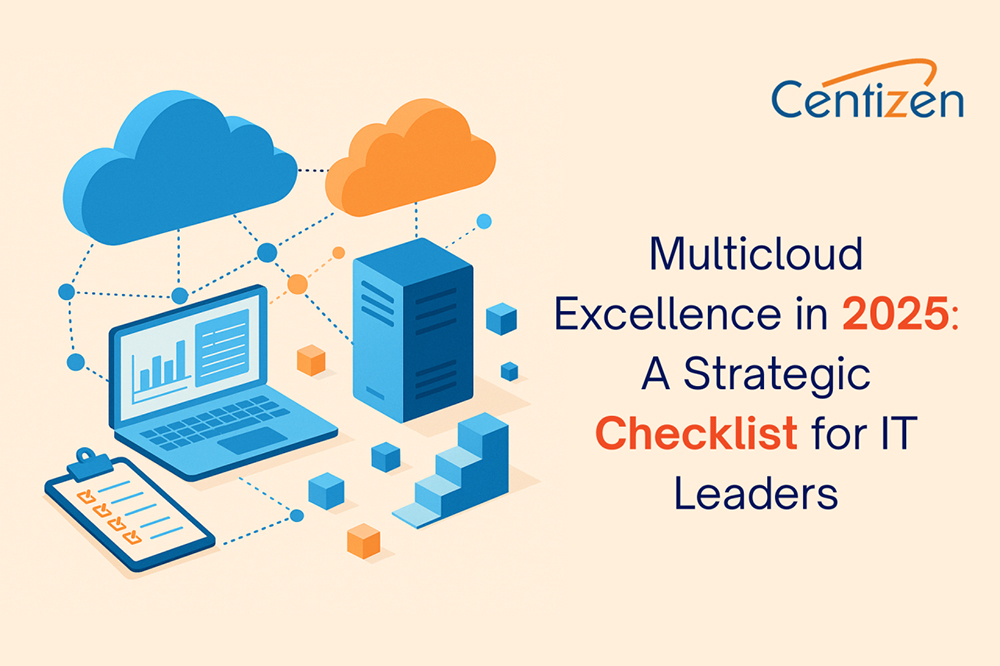Multicloud Excellence in 2025: A Strategic Checklist for IT Leaders

In today’s digital-first landscape, the question is no longer whether to support multicloud—but how to excel at it.
With most organizations now operating across multiple cloud environments—spanning public hyperscalers, private clouds, edge infrastructure, SaaS platforms, and low-code services—the real challenge is maximizing business value from this complex ecosystem. Multicloud strategies must evolve from basic enablement to optimized operations, driven by agility, cost-efficiency, AI-readiness, and risk reduction.
Here’s a comprehensive 2025 multicloud checklist, distilled from expert insights across leading enterprises.
1. Define and communicate a business-aligned cloud vision
A clear cloud operations vision statement helps align technical decisions with business objectives. Multicloud is often a response to constraints like vendor lock-in, data residency laws, or mergers. But forward-thinking enterprises go further, using multicloud as a lever for competitive advantage.
Checklist actions:
- Draft and regularly update a cloud vision, services roadmap, and operations review (biannually).
- Establish a Cloud Center of Excellence (CCoE) to standardize governance and best practices.
- Use metrics and real-world cases (e.g., Broadcom–VMware shifts) to communicate competitive advantages.
2. Align multicloud strategy with GenAI and AI adoption
Many enterprises adopted multicloud before the GenAI revolution. Today, multicloud strategies must evolve to support diverse AI models and region-specific data needs.
Checklist actions:
- Track usage of GenAI services like AWS Bedrock, Azure OpenAI, and Google Vertex AI.
- Evaluate how SaaS platforms and AI agents use zero ETL data integration across environments.
- Connect AI goals with cloud architecture for long-term innovation.
3. Optimize cloud-to-cloud network performance and security
Networking remains one of the most overlooked pain points in multicloud operations. Enterprises must ensure secure, low-latency, high-performance connectivity between cloud environments.
Checklist actions:
- Assess interconnect options: AWS Direct Connect, Azure ExpressRoute, Google Cloud Interconnect.
- Design resilient network paths with end-to-end encryption and segmentation under zero-trust principles.
- Reduce public internet exposure through private interconnects and partner colocation.
4. Unify identity, access, and security monitoring across clouds
With multiple cloud environments, maintaining a centralized identity and access management (IAM) framework is crucial to avoid fragmented security postures.
Checklist actions:
- Implement federated identity and unified telemetry for security observability.
- Automate least-privilege policies and real-time detection across providers.
- Ensure incident response and compliance workflows work across all clouds.
5. Strategically place workloads based on cost, performance, and compliance
Multicloud is about choice—but choice needs strategy. With hundreds of instance types, edge deployments, and serverless options, workload placement decisions must be data-driven.
Checklist actions:
- Develop criteria for work placement across performance, cost, innovation, and regulatory compliance.
- Identify opportunities for containerization and cloud-agnostic frameworks to increase portability.
- Leverage edge functions for latency-sensitive use cases like IoT and media.
6. Strengthen data governance for AI-driven multicloud environments
AI agents and private LLMs demand strong data governance frameworks across clouds. Multicloud enterprises must govern sensitive data while enabling secure, AI-ready access.
Checklist actions:
- Classify data by sensitivity, residency, retention, and compliance.
- Ensure cross-cloud backup and disaster recovery strategies are in place.
- Measure governance performance through KPIs such as data accessibility and policy coverage.
7. Embrace agile architecture for application modernization
Many organizations face a growing gap between cloud capabilities and legacy app backlogs. Agile architecture and GenAI automation can accelerate modernization and reduce technical debt.
Checklist actions:
- Establish observability standards, feature flags, and canary release strategies.
- Adopt CI/CD pipelines with automated, continuous testing for cloud-native apps.
- Use GenAI to enhance SDLC automation and predict operational needs.
8. Build FinOps discipline into multicloud operations
Multicloud introduces complexity in cost tracking and optimization. Establishing FinOps as a core function helps prevent cloud waste and drives financially smart decisions.
Checklist actions:
- Forecast typical vs. peak usage to inform autoscaling and infrastructure planning.
- Automate tagging, idle resource monitoring, and ramp-down procedures.
- Use shift-left FinOps practices to manage cost during dev and test phases.
9. Integrate AIops for proactive, autonomous operations
As IT ecosystems grow, AIops platforms are key to managing service complexity, correlating alerts, and enabling predictive, not reactive, responses.
Checklist actions:
- Deploy cross-cloud observability and AIops capabilities to monitor and resolve incidents.
- Improve CI/CD and infrastructure-as-code robustness for multicloud resiliency.
- Shift from monitoring to automated remediation with GenAI and AIops tooling.
10. Foster a learning culture for cloud, AI, and cybersecurity evolution
Technology evolves fast—and people must keep pace. Building a culture of lifelong learning across dev, sec, ops, and FinOps teams is vital for sustained success.
Checklist actions:
- Promote cross-functional collaboration through hackathons, labs, and knowledge-sharing.
Invest in int - Invest in internal upskilling on AI, cloud architecture, and cybersecurity.
- Encourage certifications, gamified training, and regular hands-on experiences.
Final thoughts: The 2025 multicloud excellence framework
Excelling in multicloud isn’t just about managing complexity—it’s about strategically leveraging it to unlock competitive advantages, accelerate AI adoption, reduce costs, and boost resilience.
This checklist equips enterprise IT teams with a forward-looking framework to standardize operations, drive innovation, and align technology with business transformation goals.
Our services:
- Staffing: Contract, contract-to-hire, direct hire, remote global hiring, SOW projects, and managed services.
- Remote hiring: Hire full-time IT professionals from our India-based talent network.
- Custom software development: Web/Mobile Development, UI/UX Design, QA & Automation, API Integration, DevOps, and Product Development.
Our products:
- ZenBasket: A customizable ecommerce platform.
- Zenyo payroll: Automated payroll processing for India.
- Zenyo workforce: Streamlined HR and productivity tools.
Services
Send Us Email
contact@centizen.com
Centizen
A Leading Staffing, Custom Software and SaaS Product Development company founded in 2003. We offer a wide range of scalable, innovative IT Staffing and Software Development Solutions.
Call Us
India: +91 63807-80156
USA & Canada: +1 (971) 420-1700
Send Us Email
contact@centizen.com
Centizen
A Leading Staffing, Custom Software and SaaS Product Development company founded in 2003. We offer a wide range of scalable, innovative IT Staffing and Software Development Solutions.
Call Us
India: +91 63807-80156
USA & Canada: +1 (971) 420-1700
Send Us Email
contact@centizen.com






